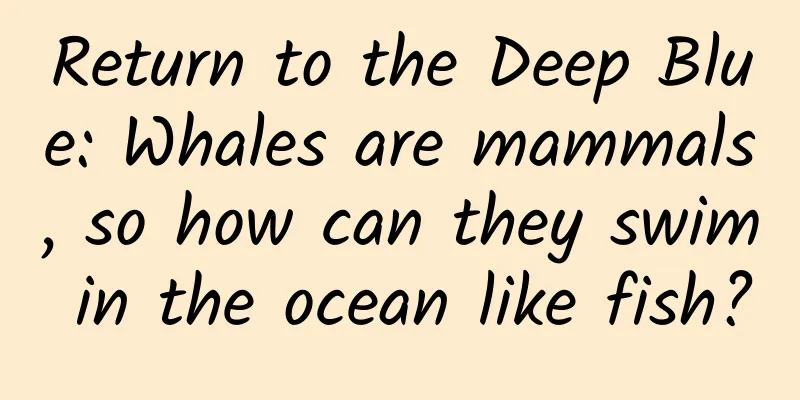Return to the Deep Blue: Whales are mammals, so how can they swim in the ocean like fish?

|
Overview Unlike fish, whales are secondary aquatic mammals that have the same lactation behavior and breathe with lungs as other mammals, and need to float regularly. They have flippers similar to fish fins, their nostrils are moved back to the top of their heads and are specialized as breathing holes, their bodies are smooth and hairless, and they lack sweat glands and sebaceous glands. In addition, they have a thick layer of fat to create a streamlined shape, which not only helps to reduce water resistance when swimming and achieve a higher swimming speed, It also plays the role of heat preservation, buffering, energy storage and increasing buoyancy. 2. Mammals Return to the Deep Blue There are three major radiation periods in the history of whale evolution. The first is the Eocene (54MY-53MY), when the terrestrial ancestors of whales The shallow waters of the Tethy Sea (the ancient Mediterranean Sea) differentiated and developed, giving rise to the Pakicetidae and Ambulocetidae families. and Remingtonocetidae, these early whales gradually adapted to the aquatic environment and laid the foundation for the later evolution of whales; Pakicetus image source newdinosaurs.com Land whales. Image source: newdinosaurs.com Remington whale family. Source: tanmizhi.com During the Middle Eocene, Protocetidae appeared in the waters of Africa, Europe, North America, India, Pakistan, etc. In the late Middle Eocene, Basilosaurus was found in almost all of the world's oceans (except Antarctica and South America), and Basilosaurus was already The necessary body forms of living whales, such as fin-like forelimbs and degenerate hind limbs. Basilosaur whales. Source: theworldofanimals.proboards.com Scientists have found that mammals that have just entered the water will have a certain degree of bone density compared to terrestrial animals. This helps semi-aquatic animals survive in shallow water, but limits their ability to walk on land for long periods of time. Bone density increases in several ways, including the Thickening and density (osteosclerosis) and excessive growth of the outer cortical bone (osteohypertrophy). The skeleton of Pakicetus exhibits osteosclerosis, and its bone microstructure is similar to that of hippopotamus. This is similar to the bones of whales and dolphins, which are good for them to enter the water to hunt. The bones of whales and dolphins now show the phenomenon of "osteoporosis", and the lighter relative bone weight makes the animals They can better adapt to the dynamic buoyancy mechanism in the deep sea, reduce inertia and save energy. In addition, the cervical vertebrae of whales are fused so that the head cannot rotate. This feature can reduce Pressure on the neck when swimming. Image source: Sun Di. Study on the genomics of finless porpoise populations and the adaptive mechanism of whale bone microstructure[D]. Nanjing Normal University, 2018. Cg is the overall bone density, Cc is the central cancellous bone density, Cp is the outer cortical bone density. In addition to the adaptation of bone structure, whales returning to the ocean also need to face the hyperosmotic environment of the ocean. Studies have shown that the urine excreted by marine whales is The osmotic pressure is 3 to 6 times that of their plasma osmotic pressure, and the kidney is the main osmotic pressure regulating organ of marine whales, so their kidney accounts for a larger proportion of their body weight. Land mammals are taller. In terms of kidney structure, whales have polycystic kidneys, which are shaped like grapes. Compared with other mammals, polycystic kidneys have a larger surface area. It is speculated that it helps produce hypertonic urine to maintain osmotic pressure balance in the body. 3. Classification Depending on the presence or absence of teeth, whales are divided into toothed whales (odontocetes) and baleen whales (mysticetes). Toothed whales have a raised fat area on their foreheads (melanic prominence) that is used to focus and regulate sound waves for echolocation. They prey on fish, squid, and other foods. Like a sperm whale in the deep sea. Toothed whales do not have a fixed migration pattern, and their social ecology is relatively complex. For example, when sperm whales are young, they will live in warm seas with female sperm whales. When they grow up, male sperm whales will They migrate to their feeding grounds in groups and live alone. Large males fight for the right to reproduce. Image source: Nature, Whales Return to Marine Mammals Although baleen whales have no teeth, they have 200-300 plate-like whiskers called baleen arranged on both sides of their upper jaws, which are used to separate food from seawater. Baleen whales are large in size and lack foreheads and the ability to echolocate, like the blue whale we are familiar with. Baleen whales have a relatively fixed migration pattern, migrating to the waters of the ocean in the summer when food is abundant. They forage in the Antarctic or Arctic and return to warmer waters in winter to give birth and raise their young. Killer whales are the natural enemies of many baleen whales, including the gray whales that have been raked by killer whales. It is the most reported of all whale species, and a small number of cubs will be attacked by large sharks. But baleen whales are not soft persimmons, such as the Arctic right whale facing the killer whale. Attacks will usually choose to fight back rather than flee. Image source: Nature, Whales Return to Marine Mammals Whale Fall The bodies of cetaceans, the fall of their bodies, and the resulting marine ecosystem are collectively referred to as whale falls. After a whale dies, its body sinks under the force of gravity. A whale fall goes through three stages. The first stage is the mobile scavenger stage , when scavenging fish and invertebrates quickly gather near the whale fall to clean up soft tissues. Whale falls will produce a large amount of gas under the action of microorganisms. If the whale fall is located in a shallow sea, it is likely to float up or run aground, and there is a risk of explosion. The second stage is the opportunist stage , where a large number of heterotrophic microorganisms and invertebrates gnaw and decompose the remaining tissues. The third stage is the chemoautotrophic stage . After the soft tissue is removed, the lipid-rich bones are exposed. At this time, the bone surface, sutures and internal parts are There are a large number of heterotrophic and chemoautotrophic bacteria growing here, and there are also a large number of mussels in the bone seams. Anaerobic bacteria will produce a large amount of sulfide when they decompose lipids. Sulfide-based chemoautotrophic bacteria are supplied for growth, and the mussels that live in symbiosis with the bacteria can also survive as a result. The skeletons of large whales can support this stage of the biological community for 40 to 80 years. The last stage is the reef stage , when whale falls with depleted organic matter become reefs suitable for biological settlement. The whale fall is Pangu, whose body turned into mountains, rivers and land in mythology. They are blessed by the "gods" and continue from generation to generation. Whale fall image source baike.so.com Whale protection Cetaceans are flagship species for aquatic wildlife conservation and indicator species for the status of marine ecological environment. However, due to the unclear status of species resources, Their survival still faces severe challenges due to habitat loss, water pollution and other issues. On November 4, 2021, the Ministry of Agriculture and Rural Affairs issued The Notice of the General Office of the Ministry of Agriculture and Rural Affairs on Strengthening the Protection and Management of Marine Mammals mentioned the following points: 1. Strengthen the protection and scientific research of marine mammals and understand the status of marine mammals and their habitats; 2. Strengthen the supervision of fishing vessels and fishing ports to reduce the harm of offshore fishing to marine mammals; 3. Implement conservation and management measures of regional fisheries organizations and strengthen the protection of marine mammals on the high seas; 4. Strengthen supervision and guidance of aquaculture production to reduce the impact on marine mammals; 5. Implement fishery graded management and formulate targeted supervision plans and measures; 6. Expand international exchanges and cooperation and strengthen supervision of imported and exported aquatic products. People have also made a lot of efforts in protecting whales. For example, the Guangxi Marine Environment Monitoring Center launched the "Protecting the Beibu Gulf Sea with You" campaign in 2021. On the one hand, it closely observed the Bryde's whales through various technical means, and on the other hand, it actively organized science popularization activities to let all sectors of society They can all gain a clearer understanding of this large and fascinating group of whales. Whales, which have moved toward land and then returned to the ocean, have carved out their own niche in the boundless ocean, relying on the ocean and giving back to it. However, in the face of global They are helpless in dealing with changes in the ocean environment. Small streams accumulate to form rivers and seas. Let us work together to give these huge creatures a beautiful home! References: [1] Nature, “Whales return to marine mammals” [2] Sun Di. Study on the genomics of finless porpoise populations and the adaptive mechanism of whale bone microstructure[D]. Nanjing Normal University, 2018. [3] Wang Baobao. Ecological overview of whale falls[J]. Biology Teaching, 2021, 46(06): 62-63. [4] Yu Xueying, Yang Feng, Zhu Jingmin, et al. Development of in vitro models and their application in cetacean research[J]. Acta Theriologica Sinica, 2018, 38(06): 597-607. DOI: 10.16829/j.slxb.150225. [5] Notice of the General Office of the Ministry of Agriculture and Rural Affairs on Strengthening the Protection and Management of Marine Mammals [6] Encyclopedia of Whales and Dolphins: The World’s Whales, Dolphins and Porpoises, by Mark Carwardine, translated by Zhu Qian et al. Copywriter: Liang Liuhong Instructors: Chu Qingzhu, Huang Jianmin Producers: Aquatic Biology Museum of Guangdong Ocean University, Chinese Society of Oceanography |
Recommend
Will sending greetings and good morning pictures on WeChat start to be charged starting March 1? Official response
Recently, a message has been circulating in many ...
The universal equation for product growth: number of users = user motivation / action cost
The article analyzes and explains the universal g...
If you don’t want the pressure cooker to explode, you must do this step right! !
There is an exploding pressure cooker in everyone...
The three key points of enterprise private domain traffic operation are "attract", "retain" and "collect".
As public domain traffic becomes increasingly exp...
[New Generation of Traders] The second episode of the real-time video of the logic of the trader Jenny's circle
[New Generation of Traders] The second issue of t...
Can eating less starve cancer cells to death? What can I eat to relieve nausea during chemotherapy? Here is the correct way to eat to fight cancer
In addition to the correct use of antiemetic drug...
Do fried chicken and first snow go together? Here are 12 dangers you need to know
Northeast China has already welcomed the first sn...
What are the functions of the Guangzhou nail salon WeChat mini program? How to make a manicure appointment app?
The love of beauty has existed since ancient times...
"Golden Cudgel" across the sea? A rare wonder appeared in one place
Suddenly a "golden hoop stick" appeared...
How do I remotely manage my server?
After renting or hosting a server, you do not nee...
When will electric cars be cheaper than fuel cars? Technological progress and economies of scale will be key factors in reducing costs
my country has 2 million new energy vehicles, but...
2019 Mobile Browser Market Share Rankings, Minimalist Quark Not on the List
When smartphones first came out, UC Browser was a...
Laoyoutiao "Writing Account Building and Operation Course" short video writing account from 0-1 practical teaching
Laoyoutiao "Writing Account Building and Ope...
Is there a solution to WeChat's space occupation? Experience WeChat's official cleaning function
If we talk about the apps that consume the most m...
A good place to drink tea in Wuhan
Wuhan high-end tea drinking is unique and very un...









